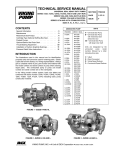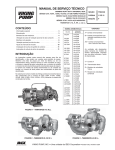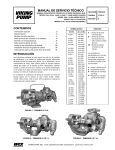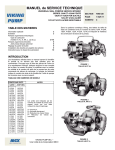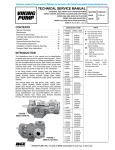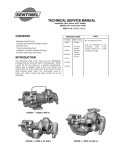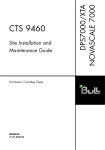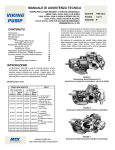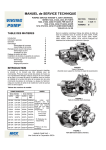Download Viking pump KK-827 Service manual
Transcript
TECHNICAL SERVICE MANUAL UNIVERSAL SEAL HEAVY DUTY PUMPS SERIES 124A, 4124A, 124AE, 4124AE AND 4124B CAST IRON SERIES 126A AND 4126A DUCTILE IRON SERIES 123A AND 4123A STEEL SERIES 127A AND 4127A STAINLESS STEEL SIZES H, HL, K, KK, L, LQ, LL SECTION TSM 630 PAGE 1 OF 13 ISSUE D . CONTENTS UNMOUNTED PUMP Special Information .……………..…………………..……………2 Maintenance Mechanical Seal Pumps……………………..……………...3 Cartridge Type Optional Stuffing Box Seal…………………….…...……3 - 4 Optional Behind the Rotor Seal……………. ……….8-9-10 Packed Pumps………………………………..……………6-7 Thrust Bearing Adjustment ………………………..……………11 Installation of Carbon Graphite Bushings…………………………………..…….……..11 Pressure Relief Valve Instructions……………...…...……..12-13 H124A H126A H123A H127A HL124A HL126A HL123A HL127A K124A K126A K123A K127A KK124A INTRODUCTION The illustrations used in this manual are for identification purposes only and cannot be used for ordering parts. Obtain a parts list from the factory or a Viking representative. Always give a complete name of part, part number and material with the model number and serial number of pump when ordering repair parts. The unmounted pump or pump unit model number and serial number are on the nameplate. In the Viking model number system, basic size letters are MODEL NUMBER CHART combined with series number (124A, 4124A, 124AE, 4124B, 126A, 4126A, 123A, 4123A, 127A) indicating basic pump construction material. UNITS PACKED MECH. SEAL KK126A KK123A KK127A L124A L124AE L126A LQ124A LQ124AE LQ126A LQ123A LQ127A LL124A LL124AE LL126A LL123A LL127A H4124A H4124B H4126A H4123A H4127A HL4124A HL4124B HL4126A HL4123A HL4127A K4124A K4124B K4126A K4123A K4127A KK4124A KK4124B KK4126A KK4123A KK4127A L4124A L4124AE L4124B L4126A LQ4124A LQ4124AE LQ4124B LQ4126A LQ4123A LQ4127A LL4124A LL4124AE LL4124B LL4126A LL4123A LL4127A A = Universal Seal Pump B = Universal Seal Pump with mechanical seal behind the rotor AE = Universal Seal Pump with larger rotor shaft Units are designated by the un-mounted pump model numbers followed by a letter indicating drive style. V = V-Belt D = Direct Connected R = Viking Speed Reducer P = Commercial Speed Reducer FIGURE 1 SIZES H AND HL FIGURE 2 SIZES K, KK AND L VIKING PUMP INC. • A Unit of IDEX Corporation • FIGURE 3 SIZES LQ AND LL This manual deals only with Series 124A, 4124A, 124AE, 4124AE, 4124B, 126A, 4126A, 123A, 4123A, 127A, and 4127A Heavy Duty Bracket Mounted Pumps. Refer to Figures 1 through 13 for general configuration and nomenclature used in this manual. Pump specifications and recommendations are listed in Catalogue Section 630, Heavy Duty Bracket Mounted Pumps, with Universal Seal Type Bracket. PRESSURE RELIEF VALVES: 1. Viking pumps are positive placement pumps and must be provided with some sort of pressure protection. This may be a relief valve mounted directly on the pump, an inline pressure relief valve, a torque limiting device or a rupture disk. 2. There are relief valve options available on those pump models designed to accept a relief valve. Options may include a return to tank relief valve and a jacketed relief valve. Pumps equipped with a jacketed head plate are generally not available with a relief valve. 3. If pump rotation is to be reversed during operation, pressure protection must be provided on both sides of pump. 4. Relief valve adjusting screw cap must always point towards suction side of pump. If pump rotation is reversed, remove pressure relief valve and turn end for end. 5. Pressure relief valves cannot be used to control pump flow or regulate discharge pressure. SPECIAL INFORMATION DANGER BEFORE OPENING ANY VIKING PUMP LIQUID CHAMBER (PUMPING CHAMBER, RESERVOIR, RELIEF VALVE ADJUSTING CAP FITTING ETC.) BE SURE: 1. THAT ANY PRESSURE IN CHAMBER HAS BEEN COMPLETELY VENTED THROUGH SUCTION OR DISCHARGE LINES OR OTHER APPROPRIATE OPENINGS OR CONNECTIONS. 2. THAT THE DRIVING MEANS (MOTOR, TURBINE, ENGINE, ETC.) HAS BEEN “LOCKED OUT” OR MADE NONOPERATIONAL SO THAT IT CANNOT BE STARTED WHILE WORK IS BEING DONE ON PUMP. For additional information on pressure relief valves, refer to Technical Service Manual TSM000 and Engineering Service Bulletin ESB-31. SPECIAL MECHANICAL SALES: Extra care should be taken in repair of these pumps. Be sure to read and follow all special instructions supplied with your pump. 3. THAT YOU KNOW WHAT LIQUID THE PUMP HAS BEEN HANDLING AND THE PRECAUTIONS NECESSARY TO SAFELY HANDLE THE LIQUID. OBTAIN A MATERIAL SAFETY DATA SHEET (MSDS) FOR THE LIQUID TO BE SURE THESE PRECAUTIONS ARE UNDERSTOOD. FAILURE TO FOLLOW ABOVE LISTED PRECAUTIONARY MEASURES MAY RESULT IN SERIOUS INJURY OR DEATH. ROTATION: Viking pumps operate equally well in a clockwise or counterclockwise rotation. Shaft rotation determines which port is suction and which is discharge. Port in area where pumping elements (gear teeth) come out of mesh is suction port. SECTION TSM 630 ISSUE D PAGE 2 OF 13 MAINTENANCE Series 124A, 4124A, 126A, 4126A, 123A, 4123A, 127A, and 4127A pumps are designed for long, trouble-free service life under a wide variety of application conditions with a minimum of maintenance. The points listed below will help provide long service life. Lubricate fittings and apply grease to pump shaft extension. Viking suggests rotating pump shaft by hand one complete revolution every 30 days to circulate the oil. Tighten all pump assembly bolts before putting pump in service after being stored. LUBRICATION: External lubrication must be applied slowly with a hand gun to all lubrication fittings every 500 hours of operation with multi-purpose grease, NLGI # 2. Do not overgrease. Applications involving very high or low temperatures will require other types of lubrication. Refer to Engineering Service Bulletin ESB-515. Consult factory with specific lubrication questions. SUGGESTED REPAIR TOOLS: The following tools must be available to properly repair series 124A, 4124A, 126A, 4126A, 123A, 4123A, 127A, and 4127A pumps. These tools are in addition to standard mechanics' tools such as openend wrenches, pliers, screwdrivers, etc. Most of the items can be obtained from an industrial supply house. PACKING ADJUSTMENT: New packed pumps require initial packing adjustment to control leakage as packing "runs in". Make initial adjustments carefully and do not over -tighten packing gland. After initial adjustment, inspection will reveal need for packing gland adjustment or packing replacement. Refer to instructions under "Disassembly," and "Assembly," page 6, regarding repacking pump. CLEANING PUMP: Keep pump as clean as possible. This will facilitate inspection, adjustment and repair work and help prevent overlooking a dirt covered grease fitting. STORAGE: If pump is to be stored, or not used for six months or more, pump must be drained and a light coat of light oil must be applied to all internal pump parts. 1. Soft headed hammer 2. Allen wrenches (some mechanical seals and set collars) 3. Packing hooks, flexible (packed pumps) 4. Mechanical seal installation sleeve. 2-751-002-900 for 1.125 inch seal; H-HL pumps. 2-751-003-900 for 1.4375 inch seal; K-LL pumps. 5. Bearing locknut spanner wrench (Source: # 471 J.H. Williams & Co. or equal) 6. Spanner wrench, adjustable pin type for use on bearing housing. (Source: # 482 J.H. Williams & Co. or equal) 7. Brass bar 8. Arbor press REPAIR: MODEL H, HL, K, KK, L, LQ and LL CARTRIDGE MECHANICAL SEAL PUMPS ITEM 1 2 3 4 5 6 7 8 9 NAME OF PART Locknut Lockwasher End Cap Lip Seal Bearing Spacer Collar (Outer) Ball Bearing Bearing Spacer Collar (Inner) Ring Half Round (Not H, HL) Bearing Housing ITEM 10 11 12 13 14 15 16 17 18 NAME OF PART Cartridge Seal Capscrew for Bracket Grease Fitting Bracket and Bushing Bracket Bushing Bracket Gasket Pipe Plug Casing (Tapped or Flanged) Rotor and Shaft ITEM 19 20 21 22 23 24 25 26 27 NAME OF PART Idler and Bushing Idler Bushing Head Gasket Idler Pin Head and Idler Pin Capscrew for Head Relief Valve Gasket Internal Relief Valve Capscrew for Valve FIGURE 4 (EXPLODED VIEW PARTS FOR SERIES 4123A, 4124A, 4124AE, 4126A, AND 4127A MODELS) SECTION TSM 630 ISSUE D PAGE 3 OF 13 DANGER BEFORE OPENING ANY VIKING PUMP LIQUID CHAMBER (PUMPING CHAMBER, RESERVOIR, RELIEF VALVE ADJUSTING CAP FITTING ETC.) BE SURE: CARTRIDGE MECHANICAL SEAL INSTALLATION 1. NOTE: Burrs left on shaft can damage O-ring on seal sleeve during installation. Inspect shaft for burrs and remove any found with a fine grade of emery cloth. 1. THAT ANY PRESSURE IN CHAMBER HAS BEEN COMPLETELY VENTED THROUGH SUCTION OR DISCHARGE LINES OR OTHER APPROPRIATE OPENINGS OR CONNECTIONS. 2. THAT THE DRIVING MEANS (MOTOR, TURBINE, ENGINE, ETC.) HAS BEEN “LOCKED OUT” OR MADE NONOPERATIONAL SO THAT IT CANNOT BE STARTED WHILE WORK IS BEING DONE ON PUMP. 3. THAT YOU KNOW WHAT LIQUID THE PUMP HAS BEEN HANDLING AND THE PRECAUTIONS NECESSARY TO SAFELY HANDLE THE LIQUID. OBTAIN A MATERIAL SAFETY DATA SHEET (MSDS) FOR THE LIQUID TO BE SURE THESE PRECAUTIONS ARE UNDERSTOOD. FAILURE TO FOLLOW ABOVE LISTED PRECAUTIONARY MEASURES MAY RESULT IN SERIOUS INJURY OR DEATH. CARTRIDGE MECHANICAL SEAL REPLACEMENT MODELS: H, HL, K, KK, L ,LQ, LL4124A AND LL4124AE CAST IRON H, HL, K, KK, L, LQ, AND LL4126A DUCTILE IRON H, HL, K, KK, LQ, AND LL4123A STEEL H, HL, K, KK, LQ, AND LL4127A STAINLESS STEEL For complete pump disassembly and assembly see pages 5 and 6. TAPERED INSTALLATION SLEEVE SHAFT COAT ROTOR SHAFT, TAPERED INSTALLATION SLEEVE AND INNER DIAMETER OF MECHANICAL SEAL WITH LIGHT OIL BEFORE ASSEMBLY. FIGURE 5 2. Clean rotor shaft and face of seal chamber. 3. Place tapered installation sleeve on shaft. Coat rotor shaft, tapered installation sleeve, and O-ring in the inside diameter of cartridge seal sleeve with a generous amount of light oil. Refer to figure 5. 4. Slide cartridge seal over installation sleeve on shaft until it contacts the seal chamber face. Remove tapered installation sleeve from shaft. 5. Place pair of half round rings in groove on shaft and turn bearing housing assembly into bracket. There are no half round rings on the "H" and "HL" size pumps. 6. Put lockwasher and locknut on shaft. Tighten locknut and bend one tang of lockwasher into slot of locknut. 7. Adjust pump end clearance as in "Thrust Bearing Adjustment" page 11. 8. Insert gland capscrews and secure gland to bracket face. NOTE: turn shaft several turns while gland is loose to center seal; then tighten gland tight enough to compress gasket. Tighten only enough to contain leakage and not to distort gland. 9. Lock cartridge seal drive collar to shaft and remove or turn centering clips out of the way so as to clear the drive collar. CARTRIDGE MECHANICAL SEAL REMOVAL: 1. Bend up tang of lockwasher and with a spanner wrench, remove locknut and lockwasher from shaft. 2. Loosen two set screws in the face of the bearing housing and remove the bearing housing assembly from the bracket. 3. Remove the pair of half round rings under the inner spacer collar from the shaft. There are no half round rings on the "H" and "HL" size pumps. 4. If flush or barrier fluid tubes are connected to the seal gland, disconnect before removing seal. Loosen the set screws on the cartridge seal collar to free the cartridge seal from the shaft. Remove the two gland capscrews and slide cartridge seal out through bearing housing opening. 10. Turn shaft by hand or jog motor to check drive collar for runout. 11. Connect flush line or vent stuffing box seals without flush line until liquid is present on start up. NOTE: For maximum seal life, flush line should be used. SECTION TSM 630 ISSUE D PAGE 4 OF 13 DANGER 4. BEFORE STARTING PUMP, BE SURE ALL DRIVE EQUIPMENT GUARDS ARE IN PLACE. FAILURE TO PROPERLY MOUNT GUARDS MAY RESULT IN SERIOUS INJURY OR DEATH. FOR "CLAMPED-IN" TYPE MECHANICAL SEAL SEAT: Flush sealing faces of both rotary member and seal seat with oil and install seal seat and seat gasket over end of shaft against machined bracket face. Install other seal gasket, seal holder, capscrews, and nuts and tighten securely. Remove tapered installation sleeve. ASSEMBLY OPTIONAL MECHANICAL SEAL MODELS: H, HL, K, KK, L, LQ, AND LL4124A CAST IRON L, LQ AND LL 4124AE CAST IRON H, HL, K, KK, L, LQ, AND LL4126A DUCTILE IRON H, HL, K, KK, LQ, AND LL4123A STEEL EXTERNALS H, HL, K, KK, LQ AND LL4127A STAINLESS STEEL FOR "O-RING" GASKET TYPE MECHANICAL SEAL SEAT: Lubricate outer diameter of O-Ring seal gasket with oil. Flush sealing faces of both rotary member and seal seat with oil and press seal seat in to bore until back, unlapped face, is flush with bore. Install seal holder, capscrews, and nuts and tighten securely. Remove tapered installation sleeve. 5. Connect flush line or vent stuffing box for seals without flush line until liquid is present on start up. NOTE: For maximum seal life, flush line should be used. TAPERED INSTALLATION SLEEVE This seal type can be installed as an alternate to the cartridge mechanical seal. The seal is setscrew driven, is simple to install and good performance will result if care is taken during installation. For complete pump disassembly and assembly see pages 6 and 7. For Step 6., disassembly, remove the appropriate nuts, capscrews, seal holder and seal seat. Remove the pipe plug in the bracket and loosen the setscrews holding the mechanical seal rotary member to the shaft. This must be done before the rotor is removed to avoid damage to the seal and the rotor shaft. MECHANICAL SEAL ROTARY MEMBER SHAFT The following steps are for mechanical seal assembly. 1. Clean rotor shaft and seal housing bore. Make sure they are free of dirt, grit and scratches. Gently radius leading edge of the shaft diameter over which seal is to be placed. FIGURE 6 Never touch mechanical seal faces with anything except clean hands or clean cloth. Minute particles can scratch the seal faces and cause leakage. 2. Place tapered installation sleeve on the shaft. Coat tapered sleeve and inside of the rotary member with a generous quantity of light oil. Grease is not recommended. Start rotary member on shaft and over tapered sleeve. Refer to Figure 6. 3. Move rotary member so setscrews are directly below seal access holes on side of bracket. Tighten all setscrews securely to shaft. Some Teflon® seals are equipped with holding clips which compress the seal springs. Remove holding clips to release springs after seal is installed on shaft. ® Registered Trademark of E.I. Dupont Co. SECTION TSM 630 ISSUE D PAGE 5 OF 13 REPAIR: MODEL H, HL, K, KK, L, LQ, AND LL ITEM 1 2 3 4 5 6 7 8 9 10 11 NAME OF PART Locknut Lockwasher End Cap Lip Seal Bearing Spacer Collar (Outer) Ball Bearing Bearing Spacer Collar (Inner) Ring Half Round (Not H, HL) Bearing Housing Packing Gland Packing Gland Nut ITEM 12 13 14 15 16 17 18 19 20 21 22 PACKED PUMPS NAME OF PART Packing Gland Capscrew Packing Packing Retainer Washer Capscrew for Bracket Grease Fitting Bracket and Bushing Bracket Bushing Bracket Gasket Pipe Plug Casing (Tapped or Flg.) Rotor and Shaft ITEM 23 24 25 26 27 28 29 30 31 NAME OF PART Idler and Bushing Idler Bushing Head Gasket Idler Pin Head and Idler Pin Capscrew for Head Relief Valve Gasket Internal Relief Valve Capscrew for Valve FIGURE 7 (EXPLODED VIEW PARTS FOR SERIES 123A, 126A, 124A AND 127A MODELS) DISASSEMBLY 1. DANGER BEFORE OPENING ANY VIKING PUMP LIQUID CHAMBER (PUMPING CHAMBER, RESERVOIR, RELIEF VALVE ADJUSTING CAP FITTING ETC.) BE SURE: Remove head from pump. Do not allow idler to fall from idler pin. Tilt top of head back when removing to prevent this. Avoid damaging head gasket. If pump is furnished with pressure relief valve, it need not be removed from head or disassembled at this point. Refer to Pressure Relief Valve Instruction, page 10. 1. THAT ANY PRESSURE IN CHAMBER HAS BEEN COMPLETELY VENTED THROUGH SUCTION OR DISCHARGE LINES OR OTHER APPROPRIATE OPENINGS OR CONNECTIONS. 2. THAT THE DRIVING MEANS (MOTOR, TURBINE, ENGINE, ETC.) HAS BEEN “LOCKED OUT” OR MADE NONOPERATIONAL SO THAT IT CANNOT BE STARTED WHILE WORK IS BEING DONE ON PUMP. 3. THAT YOU KNOW WHAT LIQUID THE PUMP HAS BEEN HANDLING AND THE PRECAUTIONS NECESSARY TO SAFELY HANDLE THE LIQUID. OBTAIN A MATERIAL SAFETY DATA SHEET (MSDS) FOR THE LIQUID TO BE SURE THESE PRECAUTIONS ARE UNDERSTOOD. Mark head and casing before disassembly to insure proper reassembly. The idler pin, which is offset in pump head, must be positioned toward and equal distance between port connections to allow for proper flow of liquid through the pump. If pump has jacketed head plate, it will separate from head when it is removed. The gasket between head and jacket head plate must be totally removed. Use new gasket when assembling pump. 2. Remove idler and bushing assembly. 3. Insert length of hardwood or brass through port opening between rotor teeth to keep shaft from turning. Bend up tang of lockwasher and with a spanner wrench, remove locknut and lockwasher from shaft. 4. Loosen two setscrews in the face of the bearing housing and remove the bearing housing assembly from the bracket. Refer to Figure 8. 5. Remove pair of half round rings under the inner spacer collar from the shaft. There are no half round rings on the "H" and "HL" size pumps. FAILURE TO FOLLOW ABOVE LISTED PRECAUTIONARY MEASURES MAY RESULT IN SERIOUS INJURY OR DEATH. SECTION TSM 630 ISSUE C PAGE 6 OF 13 BALL BEARING BEARING HOUSING ASSEMBLY SETSCREW 1. Install bracket bushing. If bracket bushing has a lubrication groove, install bushing with groove at 6.00 o'clock position in bracket. If carbon graphite, Refer to Installation of Carbon Graphite Bushings, page 11. 2. Coat shaft of rotor shaft assembly with light oil. Start end of shaft in bracket bushing turning from right to left, slowly pushing rotor in casing. 3. Coat idler pin with light oil and place idler and bushing on idler pin in head. If replacing with carbon graphite bushing, Refer to installation of Carbon Graphite Bushings, page 11. 4. Using a .010 to .015 inch head gasket, install head and idler assembly on pump. Pump head and casing were marked before disassembly to insure proper reassembly. If not, be sure idler pin, which is offset in pump head, is positioned toward the equal distance between port connections to allow for proper flow of liquid through pump. If pump is equipped with jacketed headplate, install at this time along with new gasket. SPACER COLLAR SHAFT LIPSEAL END CAP HALF ROUND RINGS SETSCREW FIGURE 8 6. Remove packing gland capscrews, slide packing gland out of stuffing box, and remove packing. NOTE: Reference cartridge seal replacement beginning on page 3 when disassembling seal pump. 7. Carefully remove rotor and shaft to avoid damaging bracket bushing. 8. Loosen two radial setscrews in flange of bearing housing and with a spanner wrench remove the outer end cap with closure and outer bearing spacer collar. 9. Remove the double row ball bearing, closure and inner bearing spacer collar from the bearing housing. Tighten head capscrews evenly. 5. When assembling packed pump, use packing suitable for liquid being pumped. Install packing, staggering the joints from one side of shaft to other. Lubricate packing rings with oil, grease, or graphite to aid assembly. Install packing gland, capscrews, and nuts. Make sure gland is installed square and nuts are tightened evenly. Tighten nuts until packing gland is snug against packing. 6. Slide inner spacer collar over shaft with recessed end facing rotor. H and HL size bearing spacer collars are not recessed. 10. Clean all parts thoroughly and examine for wear and damage. Check lip seals, ball bearing, bushings, and idler pin and replace if necessary. Check all other parts for nicks, burrs, excessive wear and replace if necessary. Wash bearings in clean solvent. Blow out bearings with compressed air. Do not allow bearings to spin; turn them slowly by hand. Spinning bearings will damage race and balls. Make sure bearings are clean, then lubricate with light oil and check for roughness. Roughness can be determined by turning outer race by hand. 11. Casing can be checked for wear or damage while mounted on bracket. Place pair of half round rings on shaft and slide inner bearing spacer collar over half round rings to lock them in place. There is no pair of half round rings on the H and HL size pumps. 7. Install the lip seal (lip toward end of shaft) in the bearing housing and turn the bearing housing into the bracket. 8. Pack the ball bearing with grease, place on the shaft and push or drive into place in housing. 9. Install the lipseal (with lip toward end of shaft) and bearing spacer collar in the outer end cap and turn the end cap into the bearing housing until tight against the bearing. Lock in place with two set screws in the flange of the bearing housing. 10. Put lockwasher and locknut on shaft. Insert length of hardwood or brass through port opening between rotor teeth to keep shaft from turning. Tighten locknut to 50-70 ft.– lbs. Torque (H, HL) or 100-130 ft. – lbs. Torque (K, KK, L, LQ, LL) . Bend one tang of lockwasher into slot of locknut. If tang does not line up with slot, tighten locknut until it does. Failure to tighten locknut or engage lockwasher tang could result in early bearing failure and cause damage to pump. Remove length of hardwood or brass from port opening. SECTION TSM 630 ISSUE D PAGE 7 OF 13 11. Adjust pump end clearance as in "Thrust Bearing Adjustment" page 11. 12. Lubricate all grease fittings with multi-purpose grease, NLGI #2. DANGER BEFORE STARTING PUMP, BE SURE ALL DRIVE EQUIPMENT GUARDS ARE IN PLACE. FAILURE TO PROPERLY MOUNT GUARDS MAY RESULT IN SERIOUS INJURY OR DEATH. REPAIR: MODELS H, HL, K, KK, L, LQ, AND LL ITEM 1 2 3 4 5 6 7 8 9 10 NAME OF PART Locknut Lockwasher End Cap Lip Seal Bearing Spacer Collar (Outer) Ball Bearing Bearing Spacer Collar (Inner) Ring Half Round (Not H, HL) Bearing Housing Capscrew for Bracket ITEM 11 12 13 14 15 16 17 18 19 20 BEHIND THE ROTOR COMPONENT MECHANICAL SEAL PUMPS NAME OF PART Lip Seal Grease Fitting Bracket and Bushing Bracket Bushing Mechanical Seal Bracket Gasket Pipe Plug Casing (Tapped or Flg.) Rotor and Shaft Idler and Bushing ITEM 21 22 23 24 25 26 27 28 NAME OF PART Idler Bushing Head Gasket Idler Pin Head and Idler Pin Capscrew for Head Relief Valve Gasket Internal Relief Valve Capscrew for Relief Valve FIGURE 9 (EXPLODED VIEW PARTS FOR SERIES 4124B MODELS) SECTION TSM 630 ISSUE D PAGE 8 OF 11 DISASSEMBLY BALL BEARING BEARING HOUSING DANGER SETSCREW BEFORE OPENING ANY VIKING PUMP LIQUID CHAMBER (PUMPING CHAMBER, RESERVOIR, RELIEF VALVE ADJUSTING CAP FITTING ETC.) BE SURE: SPACER COLLAR SHAFT 1. THAT ANY PRESSURE IN CHAMBER HAS BEEN COMPLETELY VENTED THROUGH SUCTION OR DISCHARGE LINES OR OTHER APPROPRIATE OPENINGS OR CONNECTIONS. LIPSEAL 2. THAT THE DRIVING MEANS (MOTOR, TURBINE, ENGINE, ETC.) HAS BEEN “LOCKED OUT” OR MADE NONOPERATIONAL SO THAT IT CANNOT BE STARTED WHILE WORK IS BEING DONE ON PUMP. 3. THAT YOU KNOW WHAT LIQUID THE PUMP HAS BEEN HANDLING AND THE PRECAUTIONS NECESSARY TO SAFELY HANDLE THE LIQUID. OBTAIN A MATERIAL SAFETY DATA SHEET (MSDS) FOR THE LIQUID TO BE SURE THESE PRECAUTIONS ARE UNDERSTOOD. FAILURE TO FOLLOW ABOVE LISTED PRECAUTIONARY MEASURES MAY RESULT IN SERIOUS INJURY OR DEATH. 1. Mark head and casing before disassembly to insure proper reassembly. The idler pin, which is offset in pump head, must be positioned toward and equal distance between port connections to allow for proper flow of liquid through the pump. Remove head from pump. Do not allow idler to fall from idler pin. Tilt top of head back when removing to prevent this. Avoid damaging head gasket. If pump is furnished with pressure relief valve, it need not be removed from head or disassembled at this point. Refer to Pressure Relief Valve Instruction, page 12. If pump has jacketed head plate, it will separate from head when it is removed. The gasket between head and jacket head plate must be totally removed. Use new gasket when assembling pump. 2. Remove idler and bushing assembly. 3. Insert length of hardwood or brass through port opening between rotor teeth to keep shaft from turning. Bend up tang of lockwasher and with a spanner wrench, remove locknut and lockwasher from shaft. 4. Loosen two setscrews in the face of the bearing housing and remove the bearing housing assembly from the bracket. Refer to Figure 10. 5. Remove pair of half round rings under the inner spacer collar from the shaft. There are no half round rings on the "H" and "HL" size pumps. END CAP SETSCREW HALF ROUND RINGS FIGURE 10 6. Carefully remove rotor and shaft to avoid damaging bracket bushing. 7. Loosen two radial setscrews in flange of bearing housing and with a spanner wrench remove the outer end cap with closure and outer bearing spacer collar. 8. Remove the double row ball bearing, closure and inner bearing spacer collar from the bearing housing. 9. Remove the rotary member of the mechanical seal from the rotor shaft. Remove the seal seat from the bracket. 10. Clean all parts thoroughly and examine for wear and damage. Check lip seals, ball bearing, bushings, and idler pin and replace if necessary. Check all other parts for nicks, burrs, excessive wear and replace if necessary. Wash bearings in clean solvent. Blow out bearings with compressed air. Do not allow bearings to spin; turn them slowly by hand. Spinning bearings will damage race and balls. Make sure bearings are clean, then lubricate with light oil and check for roughness. Roughness can be determined by turning outer race by hand. 10. Casing can be checked for wear or damage while mounted on bracket. SECTION TSM 630 ISSUE D PAGE 9 OF 13 TAPERED INSTALLATION SLEEVE ASSEMBLY 1. Install bracket bushing. If bracket bushing has a lubrication groove, install bushing with groove at 6.00 o'clock position in bracket. If carbon graphite, Refer to Installation of Carbon Graphite Bushings, page 11. Make sure slots in the face of the bushing are towards rotor end of the bracket. 2. Clean rotor shaft and seal housing bore. Make sure they are free of dirt, grit and scratches. Gently radius leading edge of shaft diameter over which seal is to be placed. Never touch mechanical seal faces with anything except clean hands or clean cloth. Minute particles can scratch the seal faces and cause leakage. 3. 4. Place tapered installation sleeve on the shaft. Coat tapered sleeve and inside of the rotary member with a generous quantity of light oil. Grease is not recommended. Start rotary member on shaft and over tapered sleeve. Refer to Figure 11. Move rotary member all the way on the rotor shaft until it is against the rotor hub. If the seal uses setscrews to secure the seal to the shaft, tighten the setsecrews once the seal is in place. Some Teflon® seals are equipped with holding clips which compress the seal springs. Remove holding clips to release springs after seal is installed on shaft. SHAFT MECHANICAL SEAL ROTARY MEMBER FIGURE 11 10. Slide inner spacer collar over shaft with recessed end facing rotor. H and HL size bearing spacer collars are not recessed. Place pair of half round rings on shaft and slide inner bearing spacer collar over half round rings to lock them in place. There is no pair of half round rings on the H and HL size pumps. 11. Install the lip seal (lip toward end of shaft) in the bearing housing and turn the bearing housing into the bracket. 12. Pack the ball bearing with grease, place on the shaft and push or drive into place in housing. 5. Lubricate outer diameter of seal seat gasket with oil. Press seal seat into bore until back, unlapped face bottoms in bore. Make sure the seat anti-rotation pins are aligned with slots in the bracket bushing. 13. Install the lipseal (with lip toward end of shaft) and bearing spacer collar in the outer end cap and turn the end cap into the bearing housing until tight against the bearing. Lock in place with two set screws in the flange of the bearing housing. 6. Coat rotor shaft and face of mechanical seal with light oil. Start end of shaft in bracket bushing turning from right to left, slowly pushing rotor in casing. 7. Coat idler pin with light oil and place idler and bushing on idler pin in head. If replacing with carbon graphite bushing, Refer to installation of Carbon Graphite Bushings, page 11. 8. Using a .010 to .015 inch head gasket, install head and idler assembly on pump. Pump head and casing were marked before disassembly to insure proper reassembly. If not, be sure idler pin, which is offset in pump head, is positioned toward the equal distance between port connections to allow for proper flow of liquid through pump. If pump is equipped with jacketed headplate, install at this time along with new gasket. 14. Put lockwasher and locknut on shaft. Insert length of hardwood or brass through port opening between rotor teeth to keep shaft from turning. Tighten locknut to 50-70 ft.– lbs. Torque (H, HL) or 100-130 ft. – lbs. Torque (K, KK, L, LQ, LL) . Bend one tang of lockwasher into slot of locknut. If tang does not line up with slot, tighten locknut until it does. Failure to tighten locknut or engage lockwasher tang could result in early bearing failure and cause damage to pump. Remove length of hardwood or brass from port opening. 9. Tighten head capscrews evenly. ® Registered Trademark of E.I. Dupont Co. SECTION TSM 630 ISSUE D PAGE 10 OF 13 THRUST BEARING ADJUSTMENT SIZE H, HL, K, KK, L, LQ, LL PUMPS 1. Loosen the two set screws in the outer face of the bearing housing and turn this thrust bearing assembly clockwise until it can no longer be turned by hand. Back off counter-clockwise until the rotor shaft can be turned by hand with a slight noticeable drag. 2. For standard end clearance, back off the thrust bearing assembly the required length measured on the outside diameter of the bearing housing. See Table 1. 3. Tighten the two self-locking type "Allen" set screws, in the outboard face of the bearing housing, with equal force against the bracket. Your pump is now set with standard end clearances and locked. NOTE: Be sure the shaft can rotate freely. If not, back off additional length on outside diameter and check again. High viscosity liquids required additional end clearances. The amount of extra end clearance depends on the viscosity of the liquid pumped. For specific recommendations, consult the factory. Each additional ¼" turn on the outside diameter of the bearing housing is equivalent to an extra end clearance of .001". 4. TURN BRG. ADDITIONAL STANDARD HOUSING LENGTH ON END PUMP C.C.W. O.D. BRG. MODEL SIZE CLEARANCE LENGTH ON HOUSING FOR (Inch) O.D. .001" END CL. (Inch) (Inch) INSTALLATION OF CARBON GRAPHITE BUSHINGS When installing carbon graphite bushings, extreme care must be taken to prevent breaking. Carbon graphite is a brittle material and easily cracked. If cracked, the bushing will quickly disintegrate. Using a lubricant and adding a chamfer on the bushing and the mating part will help in installation. The additional precautions listed below must be followed for proper installation. 1. A press must be used for installation. 2. Be certain bushing is started straight. 3. Do not stop pressing operation until bushing is in proper position. Starting and stopping will result in a cracked bushing. 4. Check bushing for cracks after installation. Carbon graphite bushings with extra interference fits are frequently furnished for high temperature operation. These bushings must be installed by a shrink fit. 1. Heat bracket for idler to 750ºF. 2. Install cool bushing with a press. 3. If facilities are not available to reach 750ºF. temperature, it is possible to install with 450ºF. temperature; however the lower the temperature the greater the possibility of cracking the bushing. Consult factory with specific questions on high temperature applications. Refer to Engineering Service Bulletin ESB3. 124A 4124A 4124B H 126A HL 4126A 0.003 .75 0.005 1.125 0.005 1.25 0.008 2 .22 123A 4123A 127A 4127A 124A 4124A K,KK 124AE L,LQ 4124AE LL 4124B .25 126A 4126A 123A 4123A 127A 4127A TABLE 1 SECTION TSM 630 ISSUE C PAGE 11 OF 13 PRESSURE RELIEF VALVE INSTRUCTIONS DISASSEMBLY DANGER BEFORE OPENING ANY VIKING PUMP LIQUID CHAMBER (PUMPING CHAMBER, RESERVOIR, RELIEF VALVE ADJUSTING CAP FITTING ETC.) BE SURE: 1. THAT ANY PRESSURE IN CHAMBER HAS BEEN COMPLETELY VENTED THROUGH SUCTION OR DISCHARGE LINES OR OTHER APPROPRIATE OPENINGS OR CONNECTIONS. FIGURE 12 SIZE H AND HL LIST OF PARTS 1. 2. 3. 4. 5. Valve Cap Adjusting Screw Lock Nut Spring Guide Bonnet 6. 7. 8. 9. Valve Body Valve Spring Poppet Cap Gasket 2. THAT THE DRIVING MEANS (MOTOR, TURBINE, ENGINE, ETC.) HAS BEEN “LOCKED OUT” OR MADE NONOPERATIONAL SO THAT IT CANNOT BE STARTED WHILE WORK IS BEING DONE ON PUMP. 3. THAT YOU KNOW WHAT LIQUID THE PUMP HAS BEEN HANDLING AND THE PRECAUTIONS NECESSARY TO SAFELY HANDLE THE LIQUID. OBTAIN A MATERIAL SAFETY DATA SHEET (MSDS) FOR THE LIQUID TO BE SURE THESE PRECAUTIONS ARE UNDERSTOOD. FAILURE TO FOLLOW ABOVE LISTED PRECAUTIONARY MEASURES MAY RESULT IN SERIOUS INJURY OR DEATH. Mark valve and head before disassembly to insure proper reassembly. 1. Remove valve cap. 2. Measure and record length of extension of adjusting screw. Refer to "A" on Figure 12 and Figure 13. 3. Loosen locknut and back out adjusting screw until spring pressure is released. 4. Remove bonnet, spring guide, spring and poppet from valve body. Clean and inspect all parts for wear or damage and replace if necessary. FIGURE 13 SIZE K, K, L, LQ AND LL LIST OF PARTS 1. 2. 3. 4. 5. Valve Cap Adjusting Screw Lock Nut Spring Guide Bonnet 6. 7. 8. 9. 10. Valve Body Valve Spring Poppet Cap Gasket Bonnet Gasket SECTION TSM 630 ISSUE C PAGE 12 OF 13 TECHNICAL SERVICE MANUAL UNIVERSAL SEAL HEAVY DUTY PUMPS SERIES 124A, 4124A, 124AE, 4124AE AND 4124B CAST IRON SERIES 126A AND 4126A DUCTILE IRON SERIES 123A AND 4123A STEEL SERIES 127A AND 4127A STAINLESS STEEL SIZES H, HL, K, KK, L, LQ, LL SECTION TSM 630 PAGE 13 of 13 ISSUE D ASSEMBLY Reverse procedures outlined under Disassembly. If valve is removed for repairs be sure to replace in same position. Relief valve adjusting screw cap must always point towards suction side of pump. If pump rotation is reversed, remove relief valve and turn end for end. DANGER BEFORE STARTING PUMP, BE SURE ALL DRIVE EQUIPMENT GUARDS ARE IN PLACE. FAILURE TO PROPERLY MOUNT GUARDS MAY RESULT IN SERIOUS INJURY OR DEATH. PRESSURE ADJUSTMENT If a new spring is installed or if pressure setting of pressure relief valve is to be changed from that which the factory has set, the following instructions must be carefully followed. 1. Carefully remove valve cap which covers adjusting screw. Loosen locknut which locks adjusting screw so pressure setting will not change during operation of pump. 2. Install a pressure gauge in discharge line for actual adjusting operation. 3. Turn adjusting screw in to increase pressure and out to decrease pressure. 4. With discharge line closed at point beyond pressure gauge, gauge will show maximum pressure valve will allow while pump is in operation. IMPORTANT In ordering parts for pressure relief valve, always give model number and serial number of pump as it appears on nameplate and name of part wanted. When ordering springs, be sure to give pressure setting desired. VIKING PUMP INC.· A Unit of IDEX Corporation Warranty Viking warrants all products manufactured by it to be free from defects in workmanship or material for a period of one (1) year from date of startup, provided that in no event shall this warranty extend more than eighteen (18) months from the date of shipment from Viking. The warranty period for Universal Seal series pumps ONLY, shipped after July 1, 2001 (Universal Seal models listed below is three (3) years from date of startup, provide that in no event shall this warranty extend more than forty-two (42) months from the date of shipment from Viking. If, during said warranty period, any products sold by Viking prove to be defective in workmanship or material under normal use and service, and if such products are returned to Viking’s factory at Cedar Falls, Iowa, transportation charges prepaid, and if the products are found by Viking to be defective in workmanship or material, they will be replaced or repaired free of charge, F.O.B. Cedar Falls, Iowa. Viking assumes no liability for consequential damages of any kind and the purchaser by acceptance of delivery assumes all liability for the consequences of the use or misuse of Viking products by the purchaser, his employees or others. Viking will assume no field expense for service or parts unless authorized by it in advance. Equipment and accessories purchased by Viking from outside sources which are incorporated into any Viking product are warranted only to the extent of and by the original manufacturer’s warranty or guarantee, if any. THIS IS VIKING’S SOLE WARRANTY AND IS IN LIEU OF ALL OTHER WARRANTIES, EXPRESSED OR IMPLIED, WHICH ARE HEREBY EXCLUDED, INCLUDING IN PARTICULAR ALL WARRANTIES OF MERCHANTABILITY OR FITNESS FOR A PARTICULAR PURPOSE. No officer or employee of IDEX Corporation or Viking Pump, Inc. is authorized to alter this warranty. Universal Seal Pump Models: Sizes H, HL , K, KK, L, LQ, LL, LS, Q, QS, N and R in Series 124A, 4124A, 4124AE, 4124B, 224A, 4224A, 4224AE, 4224B, 324A, 4324A, 126A, 4126A, 226A, 4226A, 123A, 4123A, 223A, 4223A, 323A, 4323A, 127A, 4127A, 227A, 4227A, 327A and 4327A. VIKING PUMP INC.· Copyright 2001·













